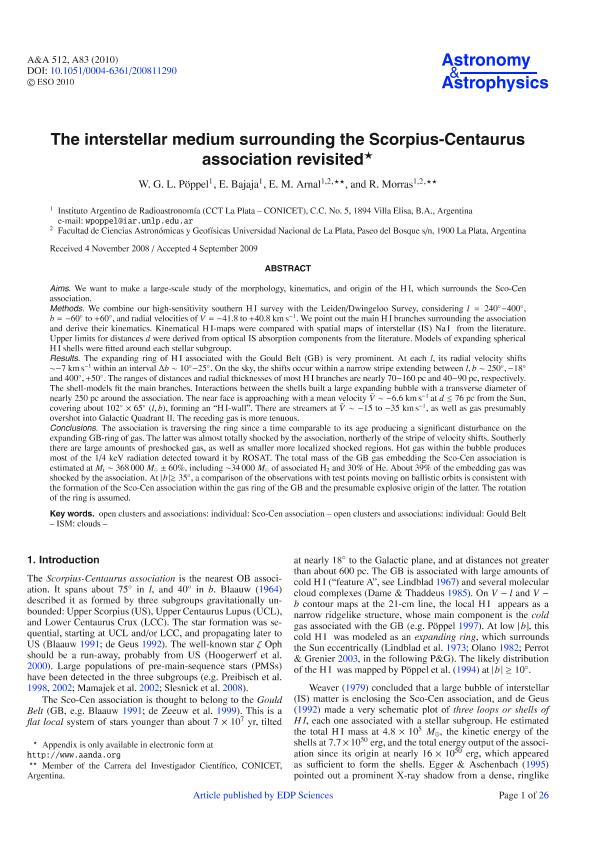Artículo
The interstellar medium surrounding the Scorpius-Centaurus association revisited
Fecha de publicación:
04/2010
Editorial:
EDP Sciences
Revista:
Astronomy and Astrophysics
ISSN:
0004-6361
Idioma:
Inglés
Tipo de recurso:
Artículo publicado
Clasificación temática:
Resumen
Aims: We want to make a large-scale study of the morphology, kinematics, and origin of the H I, which surrounds the Sco-Cen association. Methods. We combine our high-sensitivity southern H I survey with the Leiden/Dwingeloo Survey, considering l = 240◦−400◦, b = −60◦ to +60◦, and radial velocities of V = −41.8 to +40.8 km s−1. We point out the main H I branches surrounding the association and derive their kinematics. Kinematical H I-maps were compared with spatial maps of interstellar (IS) Na I from the literature. Upper limits for distances d were derived from optical IS absorption components from the literature. Models of expanding spherical H I shells were fitted around each stellar subgroup. Results: The expanding ring of H I associated with the Gould Belt (GB) is very prominent. At each l, its radial velocity shifts ∼−7 km s−1 within an interval Δb ∼ 10◦−25◦. On the sky, the shifts occur within a narrow stripe extending between l, b ∼ 250◦, −18◦ and 400◦, +50◦. The ranges of distances and radial thicknesses of most H I branches are nearly 70−160 pc and 40−90 pc, respectively. The shell-models fit the main branches. Interactions between the shells built a large expanding bubble with a transverse diameter of nearly 250 pc around the association. The near face is approaching with a mean velocity V¯ ∼ −6.6 km s−1 at d ≤ 76 pc from the Sun, covering about 102◦ × 65◦ (l, b), forming an “H I-wall”. There are streamers at V¯ ∼ −15 to −35 km s−1, as well as gas presumably overshot into Galactic Quadrant II. The receding gas is more tenuous. Conclusions: The association is traversing the ring since a time comparable to its age producing a significant disturbance on the expanding GB-ring of gas. The latter was almost totally shocked by the association, northerly of the stripe of velocity shifts. Southerly there are large amounts of preshocked gas, as well as smaller more localized shocked regions. Hot gas within the bubble produces most of the 1/4 keV radiation detected toward it by ROSAT. The total mass of the GB gas embedding the Sco-Cen association is estimated at Mt ∼ 368 000 M ± 60%, including ∼34 000 M of associated H2 and 30% of He. About 39% of the embedding gas was shocked by the association. At |b|≥ 35◦, a comparison of the observations with test points moving on ballistic orbits is consistent with the formation of the Sco-Cen association within the gas ring of the GB and the presumable explosive origin of the latter. The rotation of the ring is assumed.
Archivos asociados
Licencia
Identificadores
Colecciones
Articulos(IAR)
Articulos de INST.ARG.DE RADIOASTRONOMIA (I)
Articulos de INST.ARG.DE RADIOASTRONOMIA (I)
Citación
Pöppel, W, G. L.; Bajaja, E.; Arnal, Edmundo Marcelo; Morras, Ricardo; The interstellar medium surrounding the Scorpius-Centaurus association revisited; EDP Sciences; Astronomy and Astrophysics; 512; 4-2010; 1-26
Compartir
Altmétricas




